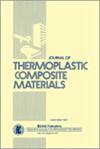基于聚乙烯醇/壳聚糖/葡萄籽提取物的生物聚合物共混复合膜,通过绿色方法用于柔性光电器件
IF 3.4
4区 材料科学
Q2 MATERIALS SCIENCE, COMPOSITES
引用次数: 0
摘要
对环境问题的日益关注吸引了各领域研究人员对环保材料的关注。本研究采用绿色方法,在聚乙烯醇(PVA)和壳聚糖(CS)的基础上掺入不同浓度的葡萄籽(GS),制成生物聚合物共混复合材料。傅立叶变换红外光谱(FTIR)、紫外可见光谱(UV)、场发射扫描电子显微镜(FE-SEM)和差示扫描量热仪(DSC)等多种分析技术被用来评估所制备的共混复合材料的光学、结构和热性能。紫外光谱测定了共混复合材料的光学特性,结果表明,随着 GS 的增加,吸收强度增加,而带隙能从纯共混物的 4.18 eV 下降到共混物/15 wt% GS 的 2.91 eV。通过 FE-SEM 图像确定了 GS 粒子在生物聚合物共混物中的均匀分布。DSC 结果表明,GS 含量的增加提高了共混复合材料的玻璃化转变温度。使用 LCR 表测量了交流电导率和介电常数。随着频率和 GS 用量的增加,电导率也随之升高,15 wt% 的添加量时电导率最大。与纯混合物相比,15 wt% GS 的添加量使拉伸强度提高了 50%,硬度提高了 17%,断裂伸长率降低了 19%。因此,环保型 PVA/CS/GS 生物聚合物共混复合材料具有优异的机械、热、电和介电参数,可能是柔性电子、电化学和储能设备的一种可行的绿色选择。本文章由计算机程序翻译,如有差异,请以英文原文为准。
Biopolymer blend composite films based on polyvinyl alcohol/ chitosan/ grape seed extract via green approach for flexible optoelectronic devices
The flourishing environmental concerns have grabbed the attention of researchers developing environmentally supportive materials in various fields. A green approach was used to create biopolymer blend composites based on polyvinyl alcohol (PVA) and chitosan (CS) doped with various concentrations of grape seed (GS). Various analytical techniques, such as Fourier-transform infrared spectroscopy (FTIR), UV–visible (UV) spectra, field emission scanning electron microscope (FE-SEM) and differential scanning calorimetry (DSC) were used to evaluate the optical, structural and thermal properties of the prepared blend composites. The optical properties of blend composites were determined by UV spectroscopy and the findings revealed that absorption intensity increased with increasing GS, while bandgap energy decreased from 4.18 eV for pure blend to 2.91 eV for blend/15 wt% GS. The homogeneous distribution of GS particles in the biopolymer blend was identified with FE-SEM images. DSC results showed that increasing the GS content increased the glass transition temperature of the blend composites. The AC conductivity and dielectric constant were measured using the LCR meter. The conductivity rises with increasing frequency and dosage of GS, with the greatest conductivity obtained at 15 wt% loading. In comparison to a pure blend, it was discovered that the inclusion of 15 wt% GS enhanced the tensile strength by 50%, hardness by 17% and the reduction in elongation at break by 19 %. As a consequence, environmentally friendly PVA/CS/GS biopolymer blend composites with excellent mechanical, thermal, electrical, and dielectric parameters might be a viable green option for flexible electronic, electrochemical and energy storage devices.
求助全文
通过发布文献求助,成功后即可免费获取论文全文。
去求助
来源期刊

Journal of Thermoplastic Composite Materials
工程技术-材料科学:复合
CiteScore
8.00
自引率
18.20%
发文量
104
审稿时长
5.9 months
期刊介绍:
The Journal of Thermoplastic Composite Materials is a fully peer-reviewed international journal that publishes original research and review articles on polymers, nanocomposites, and particulate-, discontinuous-, and continuous-fiber-reinforced materials in the areas of processing, materials science, mechanics, durability, design, non destructive evaluation and manufacturing science. This journal is a member of the Committee on Publication Ethics (COPE).
 求助内容:
求助内容: 应助结果提醒方式:
应助结果提醒方式:


